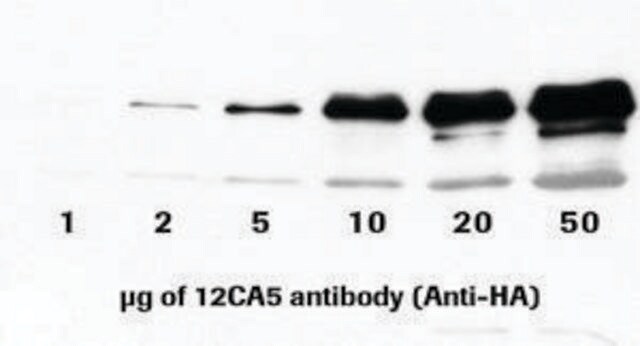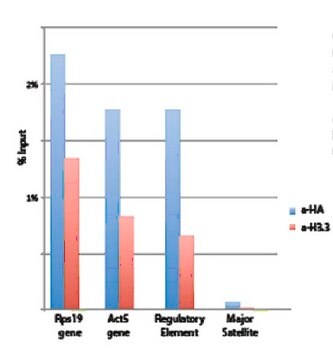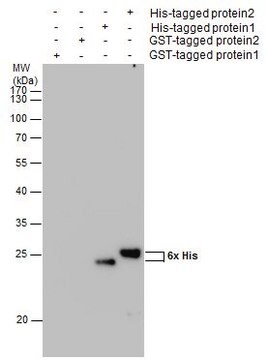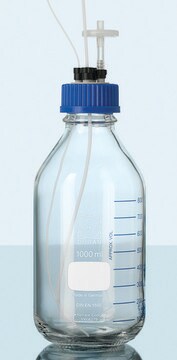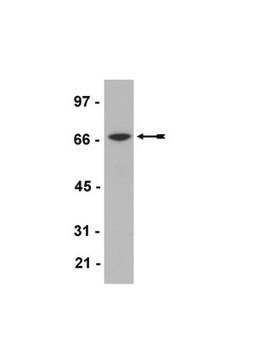05-235
Przeciwciało anty-EF1α, klon CBP-KK1
clone CBP-KK1, Upstate®, from mouse
Synonim(y):
Antygen nowotworowy CTCL, białko podobne do EF1a, czynnik elongacji 1 A-1, czynnik elongacji Tu, członek klastra receptorów leukocytów 7, supresor raka szyjki macicy 3, podjednostka alfa czynnika elongacji 1, czynnik elongacji 1-alfa, czynnik elongacji translacji eukariotycznej.
About This Item
Polecane produkty
pochodzenie biologiczne
mouse
Poziom jakości
forma przeciwciała
purified antibody
rodzaj przeciwciała
primary antibodies
klon
CBP-KK1, monoclonal
reaktywność gatunkowa
bacteria, Saccharomyces cerevisiae
reaktywność gatunkowa (przewidywana na podstawie homologii)
mammals
producent / nazwa handlowa
Upstate®
metody
immunoprecipitation (IP): suitable
western blot: suitable
izotyp
IgG1κ
numer dostępu NCBI
numer dostępu UniProt
Warunki transportu
dry ice
docelowa modyfikacja potranslacyjna
unmodified
informacje o genach
human ... EEF1A1(1915)
Opis ogólny
Izoforma alfa 1 jest identyfikowana jako autoantygen u 66% pacjentów z zespołem Felty'ego. Stwierdzono, że gen dla izoformy alfa 1 ma wiele kopii na wielu chromosomach, z których niektóre, jeśli nie wszystkie, reprezentują różne pseudogeny. Gen dla izoformy alfa 2 może mieć krytyczne znaczenie dla rozwoju raka jajnika.
Specyficzność
Immunogen
Zastosowanie
4 µg poprzedniej partii immunoprecypitowało EF1α z lizatu komórek A431 RIPA.
Transport białek
Metabolizm RNA i białka wiążące
Białko wiążące RNA (RBP)
Jakość
Western Blot Analysis:
0.5-2 µg/mL of this lot detected EF1α in RIPA lysates from non-stimulated A431 cells. Previous lots detected EF1α in human Jurkat and mouse 3T3/A31 RIPA cell lysates.
Opis wartości docelowych
Postać fizyczna
Przechowywanie i stabilność
Zalecenia dotyczące postępowania:
Po otrzymaniu, a przed zdjęciem korka, odwirować fiolkę i delikatnie wymieszać roztwór. Rozdzielić do probówek mikrowirówkowych i przechowywać w temperaturze -20°C. Unikać powtarzających się cykli zamrażania/rozmrażania, które mogą uszkodzić IgG i wpłynąć na działanie produktu.
Komentarz do analizy
Pozytywna kontrola antygenu: Katalog #12-301, niestymulowany lizat komórek A431. Dodać 2,5 µl 2-merkaptoetanolu/100 µl lizatu i gotować przez 5 minut w celu zredukowania preparatu. Załadować 20 µg zredukowanego lizatu na pas do minigelów.
Inne uwagi
Informacje prawne
Oświadczenie o zrzeczeniu się odpowiedzialności
Nie możesz znaleźć właściwego produktu?
Wypróbuj nasz Narzędzie selektora produktów.
Kod klasy składowania
12 - Non Combustible Liquids
Klasa zagrożenia wodnego (WGK)
WGK 1
Temperatura zapłonu (°F)
Not applicable
Temperatura zapłonu (°C)
Not applicable
Certyfikaty analizy (CoA)
Poszukaj Certyfikaty analizy (CoA), wpisując numer partii/serii produktów. Numery serii i partii można znaleźć na etykiecie produktu po słowach „seria” lub „partia”.
Masz już ten produkt?
Dokumenty związane z niedawno zakupionymi produktami zostały zamieszczone w Bibliotece dokumentów.
Nasz zespół naukowców ma doświadczenie we wszystkich obszarach badań, w tym w naukach przyrodniczych, materiałoznawstwie, syntezie chemicznej, chromatografii, analityce i wielu innych dziedzinach.
Skontaktuj się z zespołem ds. pomocy technicznej

